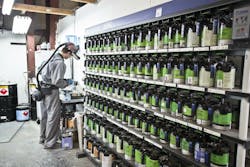Running a paint department can be a costly endeavor for many repair businesses. That said, it is also one area where costs can be controlled and a strong level of influence can be exerted.
Prior to becoming owner and general manager of J. Hunter & Associates, an independent provider of auto body paint and materials management, Jim Compton spent several years working for large jobbers. In the process, he started developing tools to analyze customer purchases.
“We started to see some patterns: The shops that were making money and had a strong profit margin on materials had some similar characteristics,” he says.
Compton started analyzing what shops purchased and consumed and compared it to key inputs from the shop to develop KPIs for the paint department. Compton discusses the key KPIs for improved paint and materials management.
First, you’ll want to start with all of your materials purchases from the jobber and separate the P&M costs from the other expenses. Then, you’ll want to take a few key inputs from your shop, such as gross sales, cycle time, monthly car count, and average repair order. Then you can do a bunch of math and make key comparisons, which can be utilized for different positions in the shop. There are three KPIs that I have found are the most important to track:
1.) Material sales and cost as a percentage of gross sales. From the shop owner’s perspective, he or she wants to know if the shop is doing quality repairs and making money from doing those repairs. You will want to look at material sales and cost as a percentage of gross sales, as well as cost per category. For example, how much of your P&M expenses is color taking up? Or clear? You’ll want to look at body labor, paint labor, refinish material sales, sublet. All those different profit sectors in the shop deserve to be profitable in their own right. You want to see where dollars are spent.
2.) Hours per gallon of clear. When it comes down to the production manager, he looks at the number of vehicles going through the shop. One metric the production manager might find handy is, how many hours am I getting out the door per gallon of clear? That’s something that’s very easy for the production manager to measure. You just go to your parts department and ask how many gallons of clear have come in this week or month, then check the invoices and how many cars have gone out. Very quickly, you can get a gauge on what’s going on with material usage. A good benchmark for that is 7.5 hours of refinish per RO. Nine hours is the real sweet spot where you are starting to make a solid profit.
Color is a little bit more difficult because it comes in different sizes and variations, but clear is a very good way to see if you’re on target. Once you establish some benchmarks, you can see whether you’re above or below average.
3.) Ounces and costs per refinish hour. When you get down to the technician level, the one thing I’ve found common with all technicians is that they understand the labor hours flagged on the job. Breaking down materials in a per-hour basis seems to be the magic bullet that allows them to gauge what’s going on. If you say, “Your goal this month is to do a better job managing the liquid that goes through this shop,” that’s powerful. And by liquid, we’re talking about color, clear and surface preparation, such as primers, adhesion promoters, and sealers.
Painters are mixing most of the materials on the scale. In the better shops, they’re mixing close to 100 percent on the scale. They’re measuring the amount of color or clear they’re mixing, they’re keeping track of it by the RO on the scale. Now we’ve got a definitive measure of not only the amount of liquid per RO, but also the volume of liquid per hour. Ounces per refinish hour and costs per refinish hour are the most important metrics to track for the paint shop.
The reason I say that is that the more color you mix, the more clear you need for spraying. If you're spraying more color, you’re masking more. If you’re spraying more color, you’re probably color sanding and buffing more. It’s like the central KPI that everything else revolves around. A good benchmark for that would be under 3 ounces per color for refinish hour.
Breaking it down to the techs for refinish hours brought it down to a level where techs, painters, preppers can identify with their impact on material profits. They are the ones who are actually handling the materials and having the most impact on material usage and the profit.
You can certainly impact the way you handle and use materials. A shop’s profitability on materials to a large extent is controllable and they can have a strong influence on material margins, as opposed to other areas in the shops. We’ve been very successful and we’ve seen as much as a nine-point increase in material gross profit over a one-year period for shops that are utilizing these reports.




